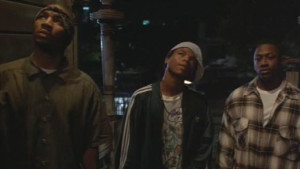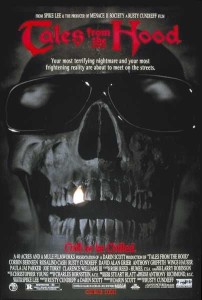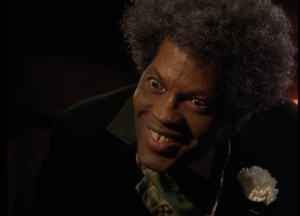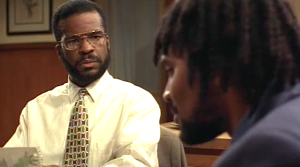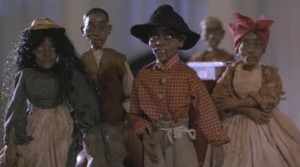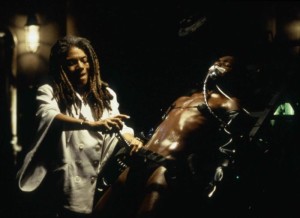What’s that? You want even more horror film coverage? Well you’ve come to the right place. Halloween is still a few days away so let us continue our foray into the realm of blood, screams, ghouls, and ghosts!
In a feature film, there’s one story being built up over an extended period of time. We follow the same characters and explore the same setting throughout. Even if there are subplots, there is always a big picture being drawn. In anthology films, there’s a new tale being introduced every few minutes tying the film together with a central theme. More stories are told, different characters are established, and many points of view are discovered. The anthology format of storytelling is especially at large within the horror genre. Some of my favorite television shows as a child followed this formula with a brand new story or stories every week: Are You Afraid of the Dark?, Beyond Belief: Fact or Fiction, and Goosebumps. I’m sure you’re sick of reading about those programs on CXF so instead, thanks to Netflix, I’m going to recall a little-known anthology horror film that’s celebrating its 20th anniversary this year.
A few years before the Leprechaun series took us to the mean streets, the Spring of 1995 would introduce the world to the urban-tinged scream machine known as Tales from the Hood. Produced by Spike Lee, this picture was similar in tone to Wes Craven’s 1991 film, The People Under the Stairs which like TFTH, took place in inner-city Los Angeles, boasted a predominantly African American cast, contained tons of violence, and had moments of humor, both intentional and not. It’s tied up by a frame story of a narrative that serves as a background to our spooky journey.
Three drug dealers are on a mission to purchase a new stash from a funeral parlor late one night. Once they arrive, they’re greeted by the home’s mysterious owner, the creepy Mr. Simms.
Feeling uneasy, the men inquire about the drugs but Mr. Simms informs them that he’ll only release them if the boys help procure them from the building. As they frolic around the home, they discover the bodies of some of the recently deceased individuals that were taken in. Each one Mr. Simms has a story for and we go into the film’s first tale: Rogue Cop Revelation.
A black councilman, Martin, lobbying for the end of police brutality is murdered by a trio of racist, white cops while a black cop, Clarence, regretfully looks on. The officers aren’t charged for their crimes and Clarence sinks into a deep depression, eventually quitting the force. After a night of drinking, Clarence starts hearing Martin’s voice ordering him to bring the cops to justice. He listens to the prophetic order and gathers the law enforcers to meet at Martin’s grave. They add insult to injury by urinating on his tombstone when Martin suddenly rises from the ground brutally slaughtering the dirty fuzz. Not feeling satisfied, Martin then targets Clarence asking why he didn’t help prevent his death.
I know this is only the first story but it might be my favorite in the film for its gratuitous violence and twist ending which I won’t spoil. Also, you find out right off the bat just how socially conscious this film is. A harsh matter such as authoritative prejudice sadly still holds true to this day. We see later on that this isn’t the only issued tackled.
I should point out that one of the cops in this story was played by Michael Massee, best known for his role as Fun Boy in The Crow and having the unfortunate distinction of being the one who accidentally murdered Brandon Lee on the film’s set when he mistakenly fired a faulty prop gun at him.
We go back to the funeral home where the posse of crooks aren’t impressed with Simms’ anecdote. Another casket is uncovered and Mr. Simms then tries to entice them with his next tale: Boys Do Get Bruised.
A teacher, Mr. Garvy, starts to worry about the home life of one of his young students, Walter, who comes to class everyday with bruises and scars. After lamenting that a “monster” is causing all of his injuries, Mr. Garvey decides to schedule a house call to Walter’s residence. His mother claims Walter is clumsy which is the cause for his injuries but it’s soon found out that his mother’s abusive boyfriend, Carl (played by David Alan Grier), is the “monster” causing all of his pain.
As someone who knows little of Grier’s work outside of In Living Color, to see him in this sort of role is actually kind of hilarious. Watching him get mangled in the segment’s climax will have you laughing on the floor. Tales’ director, Rusty Cundieff would reunite with Grier years later when he wrote for his short-lived 2008 Comedy Central variety show, Chocolate News.
The gang is growing restless but Mr. Simms directs their attention to a odd looking voodoo doll bringing us to his third story: KKK Comeuppance.
A boisterous and racist Senator, Duke Metzger, sets up his new office on an old southern slave plantation. After several groups are seen protesting him, he’s told that the plantation is haunted by the spirits of tortured slaves. He dismisses it and soon goes to work on his campaign. He then notices a painting of an old voodoo witch in his home and several of the old dolls she crafted lying in front of it. These very dolls soon come to life and fueled by the souls of the wronged slaves, make Metzger’s life a living hell. It’s do or die time as he tussles with the miniature devils and tries to put the very people he helped oppress away for good.
Corbin Bernsen’s performance as the former Klansman turned politician is so animated that you can’t help but love it. You’re just cheering for him to get eaten alive by these minis. The whole thing is almost like a Chapelle Show skit which is funny considering that Cundieff went on to write for the Dave Chapelle smash hit comedy series.
The dealers are now angry and demand the drugs from Mr. Simms who summons them to one final coffin. Inside is a man the guys presumably know. When asked who it is, the boys deny how they know him which leads to the final and harshest story story in this quartet: Hard-Core Convert.
A gang member named Crazy K is almost put to rest after a dispute with three unknown criminals. Just before he is killed, the police arrive on the scene breaking up the shooting. K survives but is subsequently put through an intense, psychological rehabilitation program ala Alex DeLarge in A Clockwork Orange. He starts to questions his motivations but soon decides who he really is inside. The last step of this process is him being confronted by the ghosts of his actual victims. K shows no remorse for his actions even those involving children and as punishment, is supernaturally transported right back to the moment where the three gunmen confront him and he’s shot dead.
Not bad for a take on A Clockwork Orange. I enjoyed seeing what Crazy K’s morals are and what caused his deep rooted hatred for others. This is definitely the most thoughtful story in the bunch making you think which direction it’ll go and what it’ll lead to.
At the story’s conclusion, it’s then revealed that the three drug dealers were in fact the people who murdered Crazy K and are actually dead themselves after a run-in with K’s gang. Mr. Simms unveils three caskets to the gang each containing their own body. They freak out and in the fantastic, ultra-cheesy ending, the funeral parlor turns into hell and Mr. Simms morphs into the devil screeching the last words of the film “WELCOME TO HELL, MOTHERFUCKERS!” as they burn in the fiery depths of the underworld.
Overall, this movie is just a blast to watch at some for its over-the-top ridiculousness. It’s social commentary on the other hand is surprisingly smart if too contrived at times. Clarence Williams III gives a superb performance as Mr. Simms. He’s eerie but compelling and you wonder the entire film what his true motives are. Not many talk about this film nowadays and I myself didn’t catch the film until many years after its release but it certainly deserves its due in the horror community. If you want to check it out, you could buy the DVD used online as it’s no longer available with no Blu-ray release in sight.

